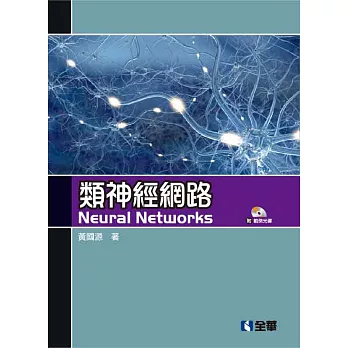第一章 簡介
1.1 圖型的定義與圖型識別的方法
1.2 Decision-theoretic Approach的圖形識別與空間分割
1.3 Pattern Recognition Systems
1.4 Non-parametric & Parametric Methods
1.5 人類頭腦的Neuron與模擬的Perceptron
1.6 Two Class Data分佈的複雜性
1.7 Activation Function
1.8 Development History of Neural Networks
1.9 Neural Network Applications
第二章 DECISION-THEORETIC PATTERN RECOGNITION 決策理論的圖形識別
Decision-theoretic Approach的圖形識別與Discriminant Functions
2.2 Nonparametric Pattern Recognition非參數式之圖形識別:
Using Discriminant Functions
2.2.1 Linear discriminant functions for pattern recognition
2.2.2 Nonlinear discriminant functions for pattern recognition
2.2.3 Perpendicular bisector
2.2.4 Minimum-distance classifier
2.2.5 Minimum-distance classifier with respect to point sets (Piecewise-linear discriminant functions, Nearest-neighbor classification)
2.2.6 N-nearest neighbor classification rule
2.3 Parametric Pattern Recognition 參數式之圖形識別
2.3.1 Bayes theorem (貝氏定理) and probability density function (pdf)
2.3.2 Bayes (Parametric) classification rule (貝氏分類法則)
2.3.3 Sequential classification
2.3.4 Neyman-Pearson test
2.3.5 Linear Classifier Design
2.3.6 Feature selection
2.3.7 Error estimation
2.4 Unsupervised Pattern Recognition
2.4.1 Minimum spanning tree (MST) clustering
2.4.2 K-means clustering
2.4.3 Hierarchical Clustering Using Dendrogram (Unsupervised Clustering) 2
第三章 PERCEPTRON 認知器數學上解Decision Boundary之困難
3.2 Perceptron
3.3 Classification
3.4 Training (Learning)
3.5 Flowcharts of Perceptron
3.6 Convergence Proof of Perceptron for Fixed Increment Training Procedure
3.7 Perceptron for Logic Operation
3.8 Layered Machine (Committee Machine/Voting Machine)
3.9 Multiclass Perceptrons
3.10 Perceptron with Sigmoidal Activation Function and Learning by Gradient Descent Method
3.11 Modified Fixed-increment Training Procedure
3.12 Multiclass Perceptron with Delta Learning Rule
3.13 Widrow-Hoff Learning Rule
3.14 Correlation Learning Rule
第四章 MULTILAYER PERCEPTRON 多層認知器 Introduction
4.2 設計Multilayer Perceptron with 1 Hidden Layer 解XOR的分類問題
4.3 Gradient and Gradient Descent Method in Optimization
4.4 Multilayer Perceptron (MLP) and Forward Computation
4.5 Back-propagation Learning Rule (BP)
4.5.1 Analysis
4.5.2 Back-propagation learning algorithm of one-hidden layer perceptron (I)
4.5.3 Back-propagation learning algorithm of one-hidden layer perceptron (II)
4.6 Experiment of XOR Classification & Discussions
4.7 On Hidden Nodes for Neural Nets
4.8 Application - NETtalk:A Parallel Network That Learns to Read Aloud
4.9 Functional-Link Net
第五章 RADIAL BASIS FUNCTION NETWORK (RBF) 輻射基底函數網路 Introduction
5.2 RBF Network 第一層的Learning Algorithm
5.3 RBF Network 第二層的Learning Algorithm
5.4 設計RBF Model to Classify XOR Patterns
第六章 SUPPORT VECTOR MACHINE (SVM) 支持向量的分類器Introduction
6.2 點到Hyperplane之距離
6.3 Role of Support Vectors in Optimal Margin Classifier for Linearly Separable Case
6.4 Find Optimal Margin Classifier for Linearly Separable Case
6.5 SVM for Nonseparable Patterns
6.5.1 Primal Problem
6.5.2 Dual Problem
6.6 Feature Transformation and Support Vector Machine (SVM) – Kernel SVM
6.6.1 Primal Problem and Optimal Separating Hyperplane之建立
6.6.2 在Dual Problem上求解新的Feature Space上的Support Vector Machine
6.6.3 Gradient Ascent的調適性的方法求 Lagrange Multipliers
6.7 Multiclss Classification Using Support Vector Machine
6.7.1 Maximum Selection Classification System Using SVMs
6.7.2 利用SVM 於數字辨識的樹狀分類系統 (Tree Classification System)
6.7.3 Multi-class Classification Using Many Binary SVMs
6.8 SVM Examples
6.8.1 直接利用Lagrange method (沒有利用KKT conditions 的Lagrange method)
6.8.2 利用加入KKT 的Lagrange method
6.8.3 Support Vector Machine (SVM) Using Feature Transformation –
Kernel SVM
6.8 Exercise
第七章 KOHONEN’S SELF-ORGANIZING NEURAL NET 自我組織的類神經網路 Winner-Take-All Learning Rule
7.2 Kohonen’s Self-organizing Feature Maps
7.3 Self-organizing Feature Maps於TSP
第八章 PRINCIPAL COMPONENT NEURAL NET 主分量類神經網路Introduction
8.2 Hebbian Learning Rule
8.3 Oja的學習法則
8.4 Neural Network of Generalized Hebbian Learning Rule
8.5 Data Compression
8.6 Effect of Adding One Extra Point along the Direction of Existing Eigenvector
8.7 Neural network的PCA的應用
第九章 HOPFIELD NEURAL NET
9.1 Lyapunov Function
9.2 Discrete Hopfield Model
9.3 Analog Hopfield Model
9.3.1 Circuits and Power
9.3.2 Analog Hopfield Model
9.4 Optimization Application of Hopfield Model to TSP
9.5 與Hopfield Neural Net有關的研究與應用
第十章 CELLULAR NEURAL NETWORK 蜂巢式類神經網路
10.1 簡介
10.2 蜂巢式類神經網路架構
10.3 蜂巢式類神經網路的穩定性分析
10.4 蜂巢式類神經網路與Hopfield神經網路的比較
10.5 離散蜂巢式類神經網路
第十一章 HAMMING NET
11.1 Introduction
11.2 Hamming Distance and Matching Score
11.3 Hamming Net Algorithm
11.4 Comparator
第十二章 ADAPTIVE RESONANCE THEORY NET (ART)
12.1 Introduction
12.2 ART1 Neural Model
12.3 Carpenter/Grossberg ART1 Net的Algorithm
12.4 Revised ART algorithm
第十三章 FUZZY, CLUSTERING, AND NEURAL NETWORKS
13.1 Fuzzy C-means Clustering Algorithm
13.2 Fuzzy Perceptron
13.3 Pocket Learning Algorithm
13.4 Fuzzy Pocket
參考文獻
附錄
Appendix A:Inner Product (內積)
Appendix B:Line Property and Distance from Point to Line
Appendix C:Covariance Matrix
Appendix D:Gram–Schmidt Orthonormal Procedure
Appendix E:Lagrange Multipliers Method
Appendix F:Gradient, Gradient Descent and Ascent Methods in Optimization
Appendix G:Derivation of Oja’s learning rule
Appendix H:類神經網路程式實驗報告範例
Appendix I:實驗報告範例之電腦程式
Appendix J:MATLAB Program of Perceptron
Appendix K:MATLAB Program of Multilayer Perceptron
Appendix L:FORTRAN Program for Perceptron
Appendix M:畫aX+bY+cZ+常數= 0的平面的Matlab電腦程式
Appendix N:Support Vector Machine的數學推導



 天天爆殺
天天爆殺  今日66折
今日66折 





















![威廉.肯特里奇[精裝]](https://im1.book.com.tw/image/getImage?i=https://www.books.com.tw/img/001/098/79/0010987920.jpg&v=66263c53k&w=110&h=110)


 博客來
博客來 博客來
博客來 博客來
博客來 博客來
博客來 博客來
博客來